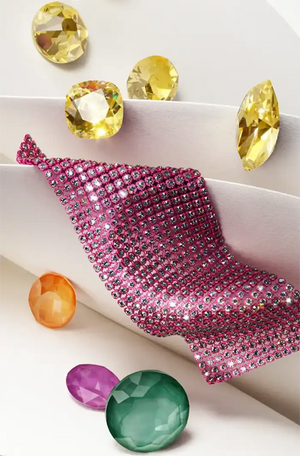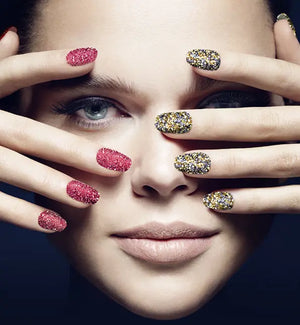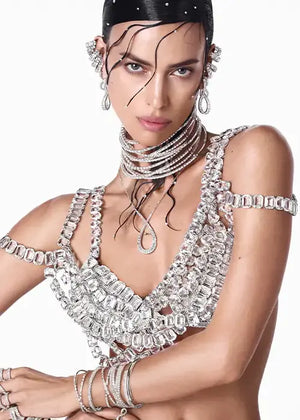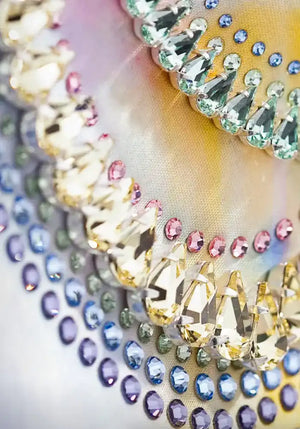
How To Tell Crystal Beads From Glass, Plastic or Stone Beads
In the world of jewellery making, the choice of materials is pivotal. It influences not only the aesthetics of the final piece but also its feel, durability, and perceived value. Beads, being a fundamental component of many designs, require special attention. This article aims to provide a comprehensive guide on distinguishing crystal beads from their glass, plastic, or stone counterparts, assisting jewellery makers in selecting the most appropriate materials for their unique creations.
What are Crystal Beads?
Crystal beads are often referred to as the 'luxury' within the bead world, widely revered for their precision cuts, clarity, and exceptional sparkle. The term 'crystal' in the context of jewellery generally refers to a type of glass that has a high lead content, which allows for maximum light refraction.
Renowned manufacturers like Swarovski or Preciosa have set high standards in crystal bead production, each applying their unique processes to achieve brilliance and a quality finish. However, it is important to note that the term 'crystal bead' is also sometimes used to describe high-quality glass beads, despite the absence of lead; Swarovski, for example, no longer uses lead in their crystal manufacturing.
How to tell if crystal beads are real?
High-quality crystal beads like Swarovski or Preciosa are incredibly consistent in size and shape, owing to their precise manufacturing processes - and this consistency makes it easy to spot fakes. To be sure, you can try comparing any beads against our seed bead size chart - this can reveal inconsistencies that might indicate a lower-quality or counterfeit product. Crystal beads should align with their stated size on the chart, whereas imitations may exhibit irregularities.
Crystal Beads vs Plastic Beads
Distinguishing between crystal and plastic beads often boils down to weight, cold feel, and visual examination. Crystal beads are noticeably heavier than plastic ones due to their lead content. The tactile coldness of crystal is another giveaway as plastic warms to touch more quickly. Visually, crystal beads have superior sparkle and sharper facet edges compared to plastic beads.
Regarding the pros and cons of each, crystal beads offer unrivalled sparkle and an undeniable touch of luxury, and their weight and cold feel contribute to a sense of quality and authenticity on any jewellery piece. On the downside, they are typically more expensive and more fragile than plastic beads.
Plastic beads, on the other hand, are affordable and highly resistant to damage, making them suitable for projects that require durability or child-friendly pieces. They also come in a vast array of colours and styles. However, they can't match the brilliance of crystal, and their lighter weight may sometimes be associated with lower quality.
Glass Beads vs Crystal Beads
Crystal and glass beads can be closely related, especially if the term 'crystal bead' is used to denote high-quality glass beads. However, if we consider lead crystal beads, the key distinguishing factors are again weight, brilliance, and cold feel.
When it comes to comparing these two materials, glass beads come in a wide range of styles and finishes, often at a lower price point than lead crystal beads. They also tend to be more durable, without the inherent fragility of lead crystal. However, they might lack the extreme sparkle and refraction characteristics of crystal beads. Crystal beads, while more expensive, deliver a premium look and feel that can significantly enhance the perceived value of a piece of jewellery.
Crystal Beads vs Stone Beads
When comparing crystal beads to stone beads, the differences are quite evident, even to the untrained eye. Stone beads, made from natural or semi-precious stones, are highly varied in terms of texture, weight, and appearance. They may have natural flaws or inclusions that add character and uniqueness to each bead, while crystals, with their uniform structure and consistency, do not exhibit these characteristics.
When it comes to weight, both crystal and stone beads can be quite heavy, but stone beads generally have a more substantial, earthy feel. A visual examination can also be revealing. While crystal beads refract light and sparkle, stone beads do not; instead, they may exhibit a natural lustre or sheen.
When comparing these two bead forms, stone beads bring a unique, natural aesthetic to jewellery pieces and maybe even be believed by many to have therapeutic or spiritual properties. They’re also durable and resistant to scratching. However, they can be pricey, particularly for rare or high-quality stones, and their inconsistent shapes might not be suitable for every design.
Crystal beads, on the other hand, offer a consistent, sparkling beauty and precision that stone beads cannot match. They are perfect for designs that require uniformity and a dash of glamour - with the main drawback being that they can chip or crack if not handled with care.
Which Beads are Best for Jewellery Making?
Determining the 'best' beads for jewellery making depends on the desired aesthetic, budget, and functionality of the piece. If you're aiming for high-end, luxurious jewellery, crystal beads, particularly those from renowned brands, are the ideal choice. Their high sparkle factor and precision cuts can elevate any design.
For more earthy, organic designs or for pieces that call for natural elements, stone beads are your best bet. Their unique patterns, textures, and colours add an element of individuality to each piece.
Plastic and glass beads are versatile options suitable for a wide range of designs. They are especially useful for makers on a budget or those creating pieces for everyday wear or use in high-activity situations, where durability is a crucial factor.








